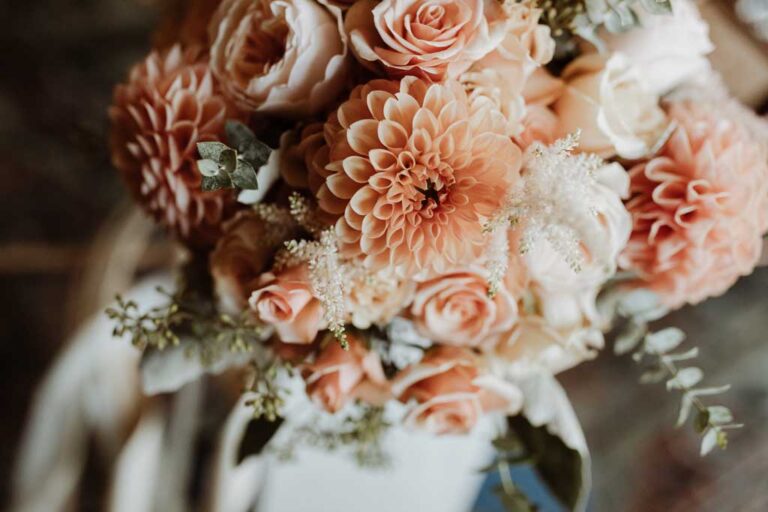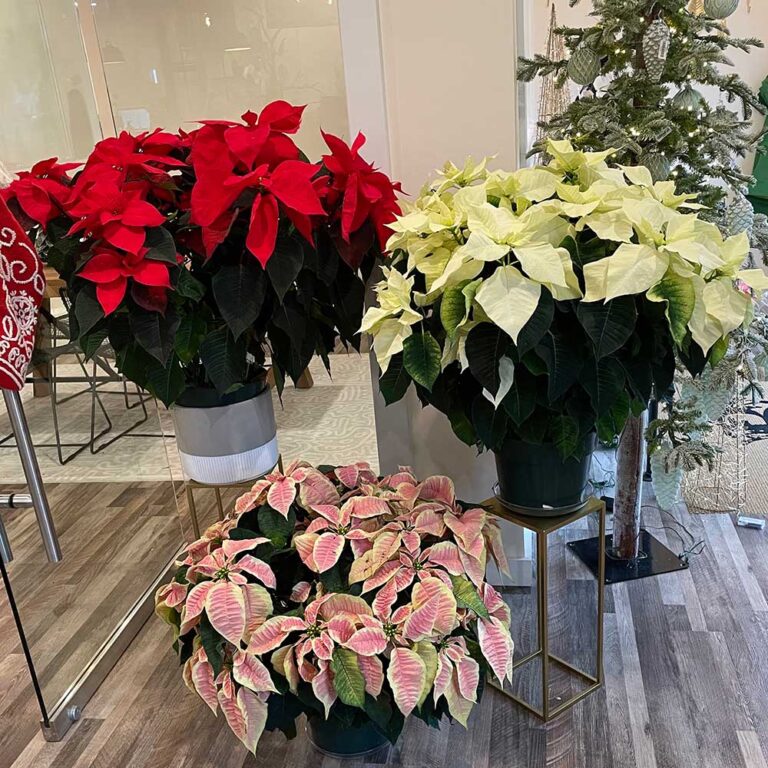
Home / The Flower Blog / The History of Poinsettias for Christmas

Poinsettias are a decorative holiday staple. They’re a symbol of the season and a decoration found in households across the United States. Everyone knows that poinsettias are the official Christmas flower – but why? When were poinsettias first associated with Christmas? Where do poinsettias come from? How did they become the holiday tradition that we know and love today?
The experts at Bedford Village Flower Shoppe have the answers! Here’s what to know about decorating with poinsettias during the holidays.
Poinsettias are the December birth flower. They are associated with good cheer, celebration, and success.
Poinsettias are native to Central America. During the time of the Aztecs, poinsettias were used to dye clothes, create cosmetics, and treat fevers. In the early 1800s, poinsettias were taken to the United States by Joel Roberts Poinsett, the first ambassador to Mexico. After visiting Mexico, he collected some poinsettia plants and sent them to his greenhouses in South Carolina. Eventually, he began sending them to friends and botanical gardens across the United States.
The poinsettias were sold at the first Philadelphia flower show as cut flowers, then were later sold in pots. In Southern California, the Ecke family was among the first to sell poinsettias as whole plants rather than cut flowers. This family is still one of the main producers of poinsettias in the United States.
When Paul Ecke Jr. sent free poinsettias to TV studios, they were featured on the holiday specials of “The Tonight Show” and Bob Hope. This served as advertising for the poinsettias and helped solidify them as the Christmas flower. Eventually, December 12th (the anniversary of Poinsett’s death) was named National Poinsettia Day.
So, where did poinsettias originate? Poinsettia Christmas flowers are not only a tradition in the United States, but they also have historic roots in Mexico. The old Mexican legend goes:
A poor girl, named Pepita, had no present to give to baby Jesus at holiday services. On the way to church, her cousin Pedro tried to cheer her up by saying that baby Jesus will be made happy by even the smallest gift when it is given by someone who loves him.
Pepita picked a handful of weeds outside the church and made them into a small bouquet. She was embarrassed by her gift but had nothing else to give. As she walked through the church with the weeds, she felt emboldened, remembering what Pedro had said to her. She put the weeds at the bottom of the nativity scene, and the weeds burst into bright red flowers. It was declared a miracle.
This is how the bright red flowers became known as the “Flores de Noche Buena”, or flowers of the holy night.
Poinsettia flowers have a distinct shape that is sometimes seen as a symbol of the Star of Bethlehem. The red color of the leaves is sometimes said to symbolize the blood of Christ, while white leaves represent the purity of Christ.
You can get poinsettias for Christmas from any reputable florist in your area, like Bedford Village Flower Shoppe. A good florist will sell poinsettias of the highest quality, with the most colorful leaves and the lushest foliage.
Poinsettias can be given at any time during the holiday season, but they are especially meaningful around Christmastime.
Poinsettias make an excellent decoration in living rooms, dining rooms, and family rooms, but keep them out of range from pets and children that might break off branches. Poinsettias secrete a sap that can upset your stomach and cause mild irritation.
Find the best poinsettias and holiday flower arrangements at the Bedford Village Flower Shoppe. Our reputable florists use fresh-cut seasonal flowers to create the most lovely winter flower arrangements. Call today to have poinsettias delivered to your home or that of a friend. See our service area to find out if we can deliver to you!
Bedford Village Flower Shoppe
634 Old Post Road
Bedford, NY 10506
info@bedfordvillageflowershoppe.com
Mon – Fri: 10am – 5pm
Sat: 10am – 3pm
Sun: Closed
Same Day Delivery:
Orders must be placed before 3pm M – F, and 12pm Sat
Floral Arrangement Delivery Areas
©2023 Bedford Village Flower Shoppe. All rights reserved. Website by Action & Co.